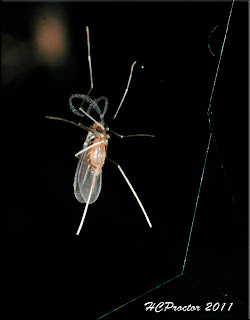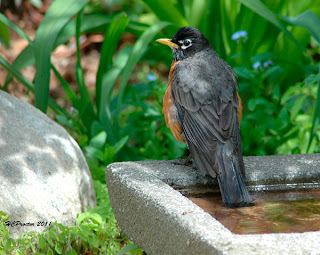 |
| Thread horn meets deadly threads: Male Chironomid Midge |
Autumn is upon the Home Bug Garden. The days are shortening,
the sun noticeably dimmer, the warmth of August gone, and the diversity of
insect life noticeably reduced. It is time to start girding the mind with
memories to hold together over the long, long, insect-free months until next
spring.
 |
| Sylvicola sp. (Anisopodidae) - a Wood Gnat |
Well, not completely insect-free. A larder beetle or two and
may be a spider beetle (and certainly house spiders) or a meal moth will pop-up
now and then. And there is always the chance that something new and interesting
will emerge from hibernation to be found batting at a winter window. Also, once
the potted plants are moved back in doors, the inevitable hidden aphid will
break dormancy and overrun an herb or flower. The pots too will mete out a
miasma of tiny midges into the winter atmosphere – the fluttering of sciarid
flies.
 |
| Dark-winged Fungus Gnat (Sciaridae) |
One way to never finish anything is to be always starting
new projects. The HBG already has several series that are more or less moribund.
When was the last Sunday Sawfly? Wednesday Wildflower? Australian of the Week? Well, my excuse is I’m pretty much out of new pictures of identified sawflies to display. Also, I
rationalize that the bug season is the time to wallow in the diversity, not to
reminisce about flowers or Australia. That's for the interminably long winters. So, in this season of transition, here is a new series – ‘How to Know a
Fly’. In contrast to the other, open-ended series, I envision this one as
discrete – probably 5 parts – and I hope to have it finished before Christmas. Absolutely. For sure.
 |
| A March Fly (Bibionidae) in September |
In ‘How to Know a Fly’, I intend to deal with what I see as
one of the major impediments to insect conservation: the difficulty of knowing
the true name of an insect. Although all insects may be equally interesting, in
a bug garden some insects should be more equal than others. Or, to paraphrase
Hamlet, would anyone want a garden grown rank with weeds? Clouds of mosquitoes
or swarms of flesh flies emanating from someone’s backyard are unlikely to
advance the cause of insect conservation.
 |
| A Crane Fly (Tipulidae) - aka Daddy Longlegs |
For example, can you distinguish a Crane Fly from a giant
mosquito? An Anopheles mosquito wriggler
from that of a harmless Dixella
midge? An Ochlerotatus mosquito tumbler
from the pupa of a predatory Chaoborus
midge? When I started our pond I knew craneflies from mosquitoes, but not the
others – and mistakenly executed many of the ‘more equal’ flies before deciding
that I should learn the names of the insects that I was killing. I thought I
would be learning mosquito names, but instead I learned midges.
 |
| Psychoda sp. - a Moth Fly (Psychodidae) |
And on this point hangs one of the contradictions of insect
conservation – to know an insect you often need to kill it and mount it on a
pin. This isn’t true of birds – there are many well illustrated guides to birds
and a pair of binoculars and some patience is usually all one needs to learn a
name. This is also true of a wildflower – picking apart a flower is usually
the worst one need do (well, sometimes you need the roots). But even with
butterflies, determining the actual species name may involve capturing a
specimen.
 |
| March Fly with a name - Penthetria heteroptera (Say, 1823) |
Field guides do help and one can be reasonably sure of the identity of at least the family and sometimes the genus of an insect by comparing live bugs or pictures to plates in books or surfing the incomparable
BugGuide. But there are orders of magnitude more insect species than birds, most bugs are much smaller than even the smallest bird, and there are many insects more confusingly similar than the worst fall warblers. In most cases, learning the true name of an insect will require a specimen, microscope, and an often intimidating thing called a ‘key’. That is how the March Flies above got their name.
 |
| Name that midge |
A key, of course, can unlock a door – or a mystery – or point to something significant, as in a ‘key character’. On our path to learn the true names of flies, the first key character is the form of the wings. In spite of the official name for the order of true flies, Diptera (‘two wings’), most dipterons actually have four wings, at least in an evolutionary sense, but the hind wings are modified into a nob like structure called the haltere. Only the front wings look wing-like, and hence, Diptera.
 |
| Gall Midge (Cecidomyiidae) showing wings and halteres |
 |
| Aspen Leaf Galls probably cause by an Harmandiola Gall Midge |
In insect identification, keys usually come composed in pairs called
couplets. People like dichotomies – dividing others into friend or foe, for
example. That is simplistic – most people are neither and one’s enemies’
enemies may be temporarily friends – but it makes for simple choices.
Identification keys are built of such dichotomous and contrasting sets of
choices.
 |
| A bad fly, but a true fly, but better known as a mosquito. |
If I were to write a key to distinguish true flies from other orders
of insects, then the early couplets might run like this (X’s refer to parts of
key not given, numbers indicate go to that numbered couplet):
1. Wings present ... 2
- Wings absent
... X
2. Thorax with two pairs of membranous wings ... XX
- Thorax with
one pair of membranous wings ... 3
3. Membranous wings on mesothorax; metathorax with pair of
knob-like structures ... 4
- Membranous
wings originate on metathorax; mesothorax with leathery or shell-like processes
that cover the wings at rest (e.g. beetles, grasshoppers) or small knobs (Strepsiptera) ... XXX
4. Mouthparts usually present, often well developed and may form beaks, sponging structures, or an elongate proboscis; tarsi usually with 5
segments ... Diptera
- Mouthparts
absent; tarsi with 1-2 segments ... Hemiptera, Coccoidea (male scale insects)
 |
| Our identification hanging by its couplet |
Notice that there is only one correct path to the Diptera –
at each couplet you must make the correct choice or you will end up in the wilderness
of X’s. Also, although less obvious, this key will not help you if your fly has
no wings, if they are either broken off or they never developed. Some parasitic
flies in the Family
Hippoboscidae, for example, either never develop wings
(e.g. sheep keds) or shed there wings once a host has been found. Then again,
you must have an adult fly to use this key – and for every fly you find there once was a maggot and a pupa with no wings that cannot be identified here.
 |
| Gilled maggot of a Crane Fly floating in the HBG Pond |
And what does one do next upon knowing you have a fly? Why
then it is too another key and another key until one either gives up, runs out
of keys, or arrives at a species.
 |
| Crane Fly with 'thread horn' antennae |
I think we’ve gone on about long enough today, but I would like to
end with the great dichotomy of the Diptera. Most of the insects we think of as
flies belong to the suborder Brachycera – horse flies, deer flies, bottle
flies, bot flies, carrion flies, flower flies, bee flies, robber flies, house flies, and
the like. Characteristically, these ‘short horn’ flies have short antennae - usually with 7 or fewer segments and often highly modified.
What used to be the other half of the dichotomy, the Nematocera, have longer
antennae, typically with 8-14 segments, and these antennae tend to be simple segmented lines (although sometimes highly plumose). We call some of these flies (e.g. crane flies), but more often call them midges, gnats, and mosquitoes. Still they are real flies and usually welcome in the Home Bug Garden (mosquitoes, black flies, and biting midges excepted).
 |
| An army of Aphidoletes aphidimyza - a Gall Midge that doesn't gall |
As is often the case with dichotomies, the Diptera cannot be
divided so simply. The Nematocera is not a
natural group, but more the
not-brachyceran flies. One of my favourite nematocerans is the Aphid Midge
Aphidoletes aphidimyza (Rondani, 1847) – a Gall Midge (Cecidomyiidae)
that makes no galls, but eats honeydew as an adult and aphids as a maggot. It eats aphids so assiduously that this midge is marketed as a
biological control agent for aphids in greenhouses. It slays its way through the aphids that pester my Evans Cherries too.
 |
| Aphid Midge maggots consuming Black Cherry Aphids |
Not satisfied with being just a great biocontrol agent, the Aphid Midge also exhibits a fascinating behaviour: it thumbs its thread horns at the normal nemesis of flies - the spider in its web. Those midges in the pictures above (and below) have not come to a sticky end (like the unfortunate male chironomid midge at the beginning of this post), but are hanging around in hopes of a good time. For not only does the Aphid Midge dangle safe from predators among the sticky threads, but it conducts its orgies in spider webs. Van Schelt & Mulder (2000) found that when spider webs were available, more female midges were mated and more eggs laid. Pretty interesting for an innocuous little midge.
References
Jeroan van Schelt & Sandra Mulder. 2000. Improved
methods of testing and release of Aphidoletes
aphidimyza (Diptera: Cecidomyiidae) for aphid control in glasshouses.
European Journal of Entomology 97: 511-515.
Wiegmann BM et al. 2011. Episodic radiations in the
fly tree of life. Proceedings of the National Academy of Sciences of the United
States of America, 108 (14), 5690-5.



































